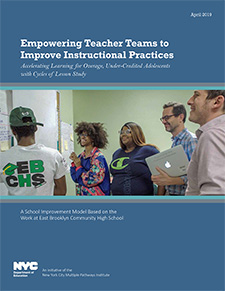Teaching doesn’t have to be a lonely act. In fact, multiple studies have found that collaborative teaching actually improves student success and leads to a stronger school culture. For East Brooklyn Community High School (EBCHS), a transfer school in Brownsville, Brooklyn, adopting lesson study proved transformational. Implementing the practice reinvigorated teacher collaboration, empowered teacher teams, and contributed to an 83 percent increase in graduation rates over a four-year span.
Lesson study, a practice with origins in Japan, is a model of professional development that provides a mechanism for deep collaboration between teachers. The lesson study process follows the following steps, repeating the cycle as needed.
- Identify a target skill that will be the focus
- Collaboratively plan a lesson
- Observe the lesson to gauge student impact
- Debrief the lesson to develop improvements
“The approach is rooted in the fact that teachers are professionals and they improve through a rich process that is not micro-managing but grounded in their deep thinking,” says EBCHS’s principal, Patrick McGillicuddy. “That’s always been the belief here, and now [with lesson study] we have a structure that matches this belief.”
While the practice has great potential for improving teaching, it requires a lot of effort. In Empowering Teacher Teams to Improve Instructional Practices, an in-depth, practical guide documenting EBCHS’s process for implementing lesson study, we break down the steps and conditions schools need to make this practice successful, and share examples of agendas and tools EBCHS developed. The following are a few takeaways from their experience.
Embrace Change
Implementing lesson study effectively is no small feat. The practice consists of many moving parts that require a concerted effort in order to work. Over the years, staff at ECBHS tried a variety of methods, some failing and others succeeding. Lesson study looks different now than it did when staff began, but the learning that happened along the way has been valuable for leaders, teachers, and students themselves. This evolution is part of the process, and having a culture of respect and supportive leadership—both of which grow stronger through lesson study practices—helped EBCHS sustain this work.
Expect Resistance
Even at EBCHS, where collaboration was strong, there was initial skepticism from teachers about planning a lesson together. On the whole, teachers are used to having autonomy over most aspects of their curriculum. However, once it became clear that lesson study was about the student experience and not a particular accountability agenda or evaluation of teaching, teachers got on board more willingly.
Teacher relationships were strengthened further as school leaders built in more opportunities to engage with each other in the practice. They framed the lesson study as a means of deepening instructional exploration and created structures for having authentic conversations about their students and the impact of their instruction, helping to relieve lingering any hesitancy.
“It feels like when we are planning lessons together, we are one brain,” noted one teacher. “Even when we disagree.”
Define Roles to Sustain the Work
Initially, EBCHS worked with facilitators from Eskolta, reDesign, and New Visions for Public Schools to develop instruction that was more targeted to specific skills. Over time, the principal and assistant principal brought together point-people from departmental teams on a monthly basis to check in on each team’s process and to plan next steps. This proved to be an important part of facilitating discussion; having clearly defined roles not only helped the process go smoothly, but it made the collaboration and reflection process more meaningful and effective and created room for growth. Over time, these team leads took more active roles and the need for external coaches diminished. Today, these teachers feel equipped to tackle these practices on their own.
Experiencing Lesson Study Helps Inspire Scaling
As teams began to solidify their practice, they shared their experiences and findings with the larger staff at end-of-year meetings. Rather than a front-of-room presentation, the lesson study teams created hands-on activities that mirrored the student experience of lesson study. This heightened other teachers’ understanding of what this practice is truly about and gave them a window into the diverse methods being executed by their colleagues.
Knowing what to expect during the early phases of implementing lesson study can help teachers and school leaders create the conditions needed for this powerful practice to take hold. A certain comfort with uncertainty and change is required, but the benefits are worth the effort. As one teacher remarked, “I’ve developed strategies that have been total game changers for me and had a huge impact on student learning. Things that I just would not have come up with on my own without the support of my lesson study team.”
Fill the form below to download “Empowering Teacher Teams to Improve Instructional Practices” an in-depth guide that delves into EBCHS’s experience and provides examples of agendas and tools for implementing lesson study.

